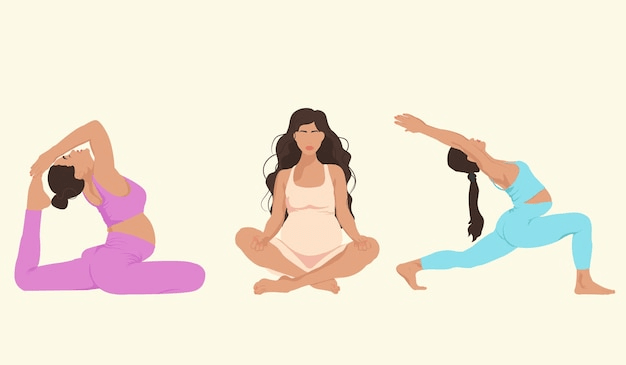Prenatal Yoga for Beginners: A Complete Guide for Expecting Moms

Pregnancy is a beautiful and transformative journey, but it can also come with its fair share of discomforts and challenges. One of the best ways to stay physically and mentally balanced during this time is by practicing prenatal yoga. This gentle form of exercise helps to keep your body flexible, improve posture, and even ease some of the common pregnancy symptoms like back pain and fatigue. Whether you’re completely new to yoga or a seasoned practitioner, prenatal yoga offers a safe and nurturing space for both you and your growing baby.
In this article, we’ll explore the benefits of prenatal yoga, some simple poses to get you started, and tips to ensure a safe and comfortable practice. Let’s dive in!
Introduction to Prenatal Yoga
Prenatal yoga is designed specifically for the unique needs of pregnant women. Unlike regular yoga, which can involve intense stretching and poses, prenatal yoga focuses on gentle movements that help support your body as it changes throughout pregnancy. It also places a strong emphasis on breathing and relaxation techniques that can prepare you for labor and delivery.
Whether you’re looking to stay active, relieve aches and pains, or simply connect with your growing baby, prenatal yoga is an excellent choice for expecting moms of all fitness levels.
The Benefits of Prenatal Yoga
Yoga during pregnancy offers a host of benefits, both physical and emotional. Regular practice can help:
- Improve flexibility and balance: As your belly grows, maintaining balance can be tricky. Yoga helps to strengthen your core muscles and improve overall stability.
- Relieve pregnancy discomforts: Poses in prenatal yoga can help alleviate back pain, sciatica, and even swelling in the legs.
- Promote relaxation: With deep breathing exercises, you can reduce stress and anxiety, which is essential for both you and your baby.
- Improve sleep: Many moms-to-be find that yoga helps them sleep better, especially during the later stages of pregnancy.
- Prepare for labor: Breathing techniques and mindful movements can help you feel more confident and relaxed as you approach your due date.
When to Start Prenatal Yoga
You can begin prenatal yoga at any point during your pregnancy, but it’s essential to consult your healthcare provider before starting any new exercise routine. For most women, starting yoga in the second trimester is ideal, as morning sickness and fatigue are more manageable by then.
However, if you’re feeling up to it, gentle prenatal yoga can even be started in the first trimester. Check out these first trimester survival tips for more insights into safely navigating the early weeks of pregnancy.
Essential Prenatal Yoga Poses
Here are a few beginner-friendly poses that are perfect for expecting mothers:
- Cat-Cow Pose (Marjaryasana-Bitilasana): This pose helps improve spinal flexibility and relieve lower back pain. Start on your hands and knees, arching your back (like a cat) and then lowering your belly (like a cow). Repeat several times while syncing your movements with your breath.
- Warrior II (Virabhadrasana II): This standing pose strengthens your legs and improves balance. With your feet wide apart, bend one knee while extending your arms parallel to the floor. This pose builds stamina and opens your hips.
- Butterfly Pose (Baddha Konasana): Sit with the soles of your feet together and gently press your knees towards the floor. This pose helps open the hips and pelvis, which is especially beneficial as your body prepares for labor.
Breathing Techniques in Prenatal Yoga
Breathing is a key component of prenatal yoga, helping to calm your nervous system and promote relaxation. One of the most useful techniques is deep belly breathing (also known as diaphragmatic breathing). To practice, sit comfortably and place one hand on your belly. Inhale deeply through your nose, allowing your belly to rise, then exhale slowly through your mouth.
Incorporating these breathing exercises into your daily life can help manage stress, reduce anxiety, and prepare you for the focused breathing required during labor.
Modifications for Each Trimester
As your pregnancy progresses, you’ll need to modify certain yoga poses to accommodate your changing body.
- First Trimester: Gentle stretching and simple poses like Child’s Pose and Cat-Cow are ideal. Avoid deep twists and poses that require intense balance.
- Second Trimester: You can safely build strength with poses like Warrior II, but be mindful of overstretching as your body produces the hormone relaxin, which loosens your joints.
- Third Trimester: Focus on restorative poses and breathing exercises to prepare your body and mind for labor. Sitting on a yoga ball for gentle stretches can also help.
Avoiding Common Yoga Mistakes During Pregnancy
While prenatal yoga is generally safe, there are a few poses and movements to avoid during pregnancy, including deep backbends, lying on your belly, or holding your breath for extended periods. Always listen to your body, and don’t push yourself beyond your comfort zone.
Combining Yoga with Other Forms of Exercise
Prenatal yoga is a great complement to other low-impact forms of exercise, like walking or swimming. Together, these activities help maintain cardiovascular health, build strength, and keep your body limber throughout pregnancy.
Mental Benefits of Prenatal Yoga
Yoga not only nurtures your body but also your mind. Regular practice helps reduce pregnancy-related stress and anxiety, encouraging mindfulness and self-awareness. It’s a great opportunity to bond with your baby and reflect on the amazing journey you’re both on.
The Role of Diet and Hydration in Prenatal Yoga
To get the most out of your yoga practice, it’s essential to eat light before your session and stay hydrated. Drink plenty of water before, during, and after your yoga practice to support your body’s increased fluid needs.
Cravings and food aversions are also a normal part of pregnancy. Understanding the changes in your appetite can help you adjust your diet accordingly. For more information, check out this article.
Postnatal Benefits of Yoga
After your baby arrives, yoga can play an important role in your recovery. Postnatal yoga helps rebuild strength, improve posture, and ease the transition back into physical activity. Plus, it offers a relaxing way to find balance as you adjust to your new role as a mother.
Conclusion
Prenatal yoga is a wonderful way to stay active, reduce stress, and prepare for the arrival of your little one. Whether you’re just starting out or have been practicing for years, prenatal yoga offers countless benefits for both your physical and emotional well-being. Take things slow, listen to your body, and enjoy the journey of pregnancy through mindful movement and breath.






